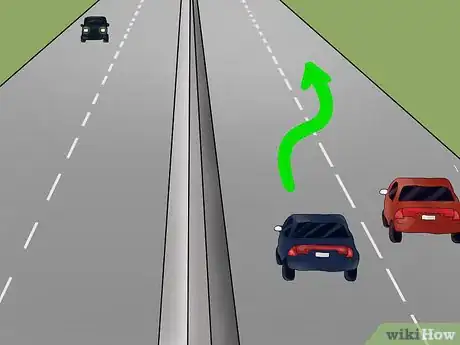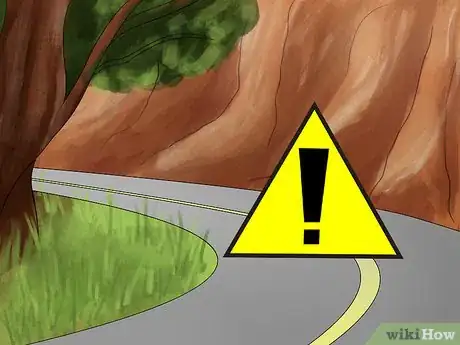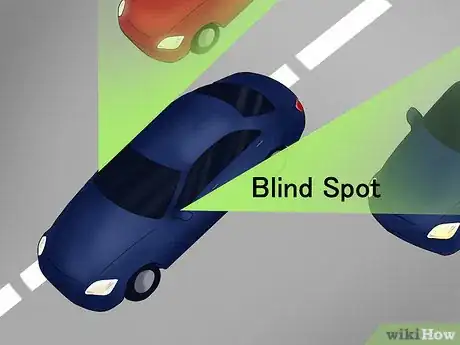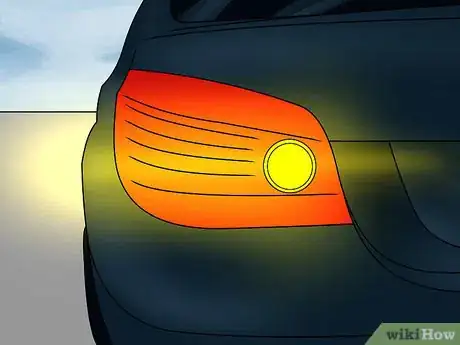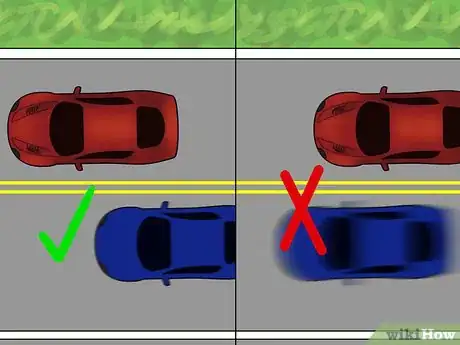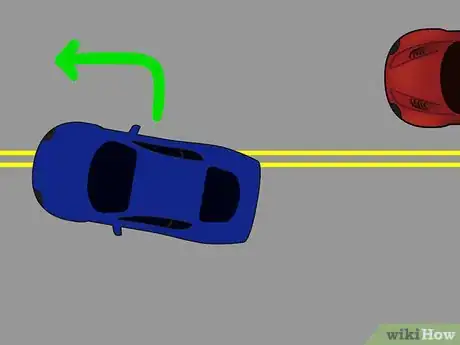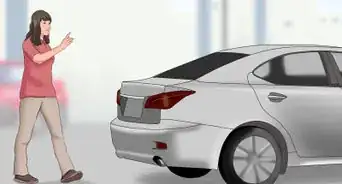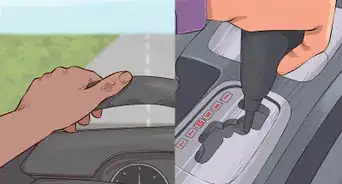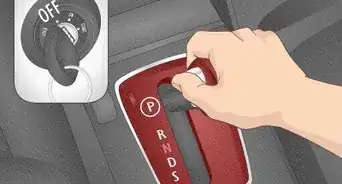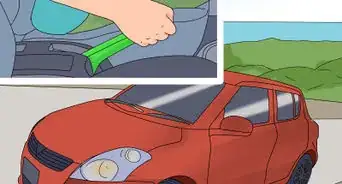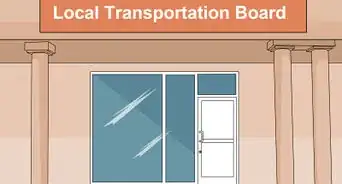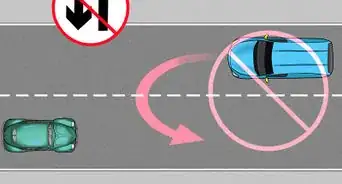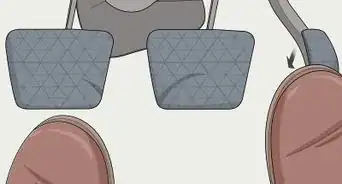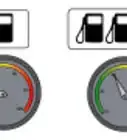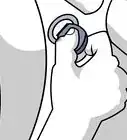This article was co-authored by Simon Miyerov. Simon Miyerov is the President and Driving Instructor for Drive Rite Academy, a driving academy based out of New York City. Simon has over 8 years of driving instruction experience. His mission is to ensure the safety of everyday drivers and continue to make New York a safer and efficient driving environment.
There are 8 references cited in this article, which can be found at the bottom of the page.
This article has been viewed 55,104 times.
Passing (also sometimes called overtaking) is the act of moving ahead of another, slower moving car on the road. Though this can be stressful, it’s something all drivers have to do on occasion. Depending on what kind of road you are driving on, there are a number of considerations to keep in mind in order to avoid accidents and be a considerate driver while passing.
Steps
Being Aware of Your Surroundings
-
1Determine if passing is legal. There are many factors and signals to let you know whether it is legal to pass or not. Staying alert and knowledgeable will not only keep you safe from accidents but also ensure that you aren’t accidentally breaking the law.
- Know the local laws. There are many specific situations and locales where passing is illegal. For example, passing is illegal is when you are behind a school bus that is loading or unloading children. Depending on where you live, there may be other locally-specific laws that prohibit passing as well so be sure to investigate those.
- Check the line on the road. If the line is solid, that means it is illegal to pass. Only pass if the line along the road is dotted.[1] However, even if the line is dotted, it is illegal to pass if there are other road conditions that impede your ability to pass safely, such as bad weather conditions and heavy traffic.
- Check road signs as you drive. Signs that say “Do Not Pass” and others indicating that you should not pass should always be obeyed.
-
2Know what kind of street you’re driving on. If you are driving on a four-lane road or divided highway, it is generally easier and safer to pass. However, if you are attempting to pass in a two-lane road, it is much more dangerous as there is always the possibility of hitting oncoming traffic. Knowing what kind of road you are driving on and following the necessary precautions will help ensure yours and others’ safety.
- If you are driving on a two-lane road, it is not recommended to pass the driver ahead of you unless there’s a serious reason to, such as the other car driving below the speed limit. You must also be positive that you will have enough time to merge back into your original lane before running into any oncoming traffic.
- Take note of the amount of cars on the road and the speed at which traffic is moving in order to estimate how much time you have. A general rule is that you should be able to pass and return to your lane without coming within 200 feet (61 m) of a car heading towards you, but it is safest to wait until there are absolutely no cars in sight heading in the opposite direction.[2]
Advertisement -
3Be aware of other possible obstacles. Though drivers often only focus on the road ahead, you should always be aware of the entire area you are driving in. As a general rule, you should never pass if you have a restricted view or are driving in an unpredictable or unfamiliar area.
- Hills and curves can restrict your view and make it difficult to see oncoming traffic. If at any time your line of sight is restricted by a hill, weather conditions, or other circumstances, do not attempt to pass.[3]
- If you see cars on side roads that merge into the lane you are trying to move into, be sure to give them the right of way as they likely are not watching for you.
- Non-vehicular obstacles are also something to watch out for. For example, if there is a slew of bikers or deer darting about in rural areas, you want to be sure there is no chance that you will hit them.
- Watch for erratic or reckless drivers. If you see a car swerving all over the road, it’s better to stay far behind them than try to pass.
- It’s impossible to list every scenario where passing is not a good idea as it’s often unpredictable, so always use your good judgment and err on the side of caution.
Communicating with Other Drivers
-
1Scan the road for other cars. Are you in a busy, congested area where there are lots of other cars to be aware of or are you in an almost deserted area? If you are on a road with lots of traffic, it may be best to just stay in your lane unless you are an experienced and confident driver.
- Check the road ahead simply by looking ahead but also be sure to see what the traffic is like behind you by using your rearview and side mirrors. Drivers have a tendency to only look ahead but you should be aware of your entire surroundings at all times.
- As you watch for drivers and other potential obstacles, be sure that you are still driving smoothly and following all other laws. When attempting to pass, some drivers begin to speed without even realizing it so be sure to stick to all other good driving habits.
-
2Check your blind spot. A blind spot is an area of the road that can’t be seen in your car mirrors. When determining if it’s safe to pass, you must always check your blind spot instead of only relying on your mirrors.
- To check your blind spot, do a “shoulder-check.” This involves turning your head to look over your shoulder towards the lane you want to merge into. Failure to check the blind spots is how many accidents are caused, particularly with motorcyclists so never forget this important step before passing.
- Each car is unique so it’s always best to know exactly where and how big your blind spots are.[4] You can check this by adjusting the side mirrors until you can see along the side of your parked car on each mirror by looking, without having to turn your head.[5] Then, have a friend stand on the sides of the car in various spots until you figure out at which points you need to do a shoulder-check in order to see them.
-
3Signal that you want to pass. One study has found that failure to use turn signals is a leading cause of car accidents.[6] Always use your turn signal to let other drivers know you want to pass in order to avoid accidents and not break the law.
- Activate your turn signal at least 100 feet (30.5 m) before changing lanes[7] and be sure to turn it off once you have changed lanes.
- Even if there are no cars around you, you still must always signal before changing lanes. After all, you could get caught by a hidden cop or camera. Additionally, signalling will eventually become second nature to you and you will perform this step automatically.
-
4Do not try to pass if another car is trying to pass you. If you see a car approaching from behind at a rapid speed or if a car is flashing its turn signal at you, you should always play it safe and allow them to pass you first.
- If you already have your turn signal on, turn it off at this point to signal to the other driver that you are going to wait to pass after they do.
- If a car behind you has its turn signal on but is not taking any further action to pass, the driver may have simply forgotten to turn off their turn signal. However, it is still safer to not attempt to pass until it absolutely clear that the driver behind you has no intention of passing you.
-
5Be patient. Some drivers will speed up or purposely try to prevent you from passing, particularly in bad traffic. Rather than being an aggressive driver and swerving in, make sure that the other drivers are making room for you to safely pass.
- If, after activating your turn signal, you see that the car ahead of you is speeding up, do not try to pass. Different drivers have many reasons for not allowing others to pass. In some cases, it can even be as simple as the driver not noticing your turn signal and accelerating on their own initiative. Don’t make assumptions or take other drivers’ behaviors personally.
Passing Safely
-
1Determine what kind of vehicle you are passing. Bear in mind that passing a semi-truck requires different considerations than passing a regular automobile. Understand that some vehicles are more dangerous to pass than others and understand how you can minimize this risk.
- Semi-trucks have bigger blind spots, meaning parts of the road where they cannot see other drivers. These are called “no-zones” and consist of the area along both sides of the trucks that can’t be viewed by the mirrors and the areas immediately in front of and behind the truck. Be mindful of the fact that you are invisible to the truck driver in these areas when making the decision to pass. You should only pass trucks if you can confidently drive ten miles faster than them without breaking the speed limit.
- Never pass a semi-truck that is going at the speed limit or above. Not only would you be breaking the law, but you are far more likely to get into a life-threatening accident.
- When passing motorcyclists or bicyclists, you must change lanes completely. Some drivers may be tempted to only change into half the lane in order to get back into their original lane faster, but this is both illegal and poses a great hazard for the cyclist you are passing. Always make sure to give them as much distance as possible to avoid a possible accident.
-
2Gently accelerate to pass. Some drivers have a tendency to stomp on the gas pedal in order to pass as quickly as possible but it is better to gradually increase your speed as you are less likely to alarm other drivers and you will have more control over your car.
- Wait until you are about a car length away from the car you are passing and then speed up to 10–15 mph (16–24 km/h) faster than the car you are passing.
- Remember, you should have already activated your turn signal so the driver ahead of you knows you are passing.
- Know when to ease up on the speed. Only accelerate as much as you need to in order to pass and make sure to not break the speed limit.
-
3Re-enter your lane. Re-entering your original lane is not necessary if you are in a multiple-lane highway but it is required if you are in a two-lane highway. Before re-entering the lane, take note of the following to ensure it is safe to do so.
- Check the rearview and side mirrors to make sure that other vehicles are at a safe distance. Make sure you are at least three cars’ lengths ahead of the car you have passed before.
- If you are in a traffic-heavy area, take note of the other cars around you as well. For example, there may be another car ahead of you that is signalling to enter the same lane. Allow them to change lanes first.
- Do the shoulder-check to make sure nothing is in your blind spots. Motorcyclists and other vehicles can sneak up on you, so don’t forget this step.
- Before re-entering your lane, activate your turn signal to communicate your intention to change lanes to the other vehicles around you.
Community Q&A
-
QuestionIf there are broken or solid lane markings, is it safe to pass another vehicle?
 Community AnswerBroken line, yes, assuming the road is clear ahead with no oncoming traffic. If the broken line is on the right with the solid line on the left, then yes; however, If the solid line is on your side of the road, no. Never with a double solid line.
Community AnswerBroken line, yes, assuming the road is clear ahead with no oncoming traffic. If the broken line is on the right with the solid line on the left, then yes; however, If the solid line is on your side of the road, no. Never with a double solid line. -
QuestionIs it legal to pass a vehicle turning left on a one lane road?
 Community AnswerIf you would have to drive off the road to do so, then no. Otherwise, yes, it's legal.
Community AnswerIf you would have to drive off the road to do so, then no. Otherwise, yes, it's legal.
References
- ↑ http://mutcd.fhwa.dot.gov/services/publications/fhwaop02090/twtmarkings_longdesc.htm
- ↑ http://www.safeny.ny.gov/roadrule.htm
- ↑ https://driversed.com/driving-information/driving-techniques/passing.aspx
- ↑ Simon Miyerov. Driving Instructor. Expert Interview. 4 December 2019.
- ↑ http://teendriving.statefarm.com/road-to-safety/safe-driving/managing-blind-spots
- ↑ http://philadelphia.cbslocal.com/2012/05/02/new-study-says-failure-to-use-turn-signals-is-a-leading-cause-of-car-accidents/
- ↑ https://driversed.com/driving-information/driving-techniques/using-turn-or-hand-signals.aspx
- ↑ http://teendriving.com/driving-tips/on-the-road/

